Base Pair expansion powers the promise of future researchers
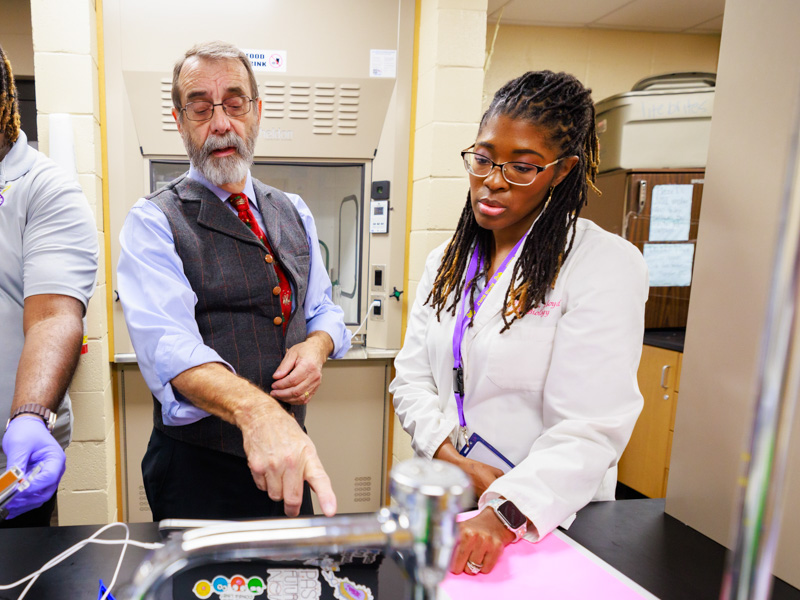
NOTE: This article originally appeared in the 2024 - 2025 issue of Graduate Report, the alumni magazine for the School of Graduate Studies in the Health Sciences.
For a small but mighty group of Hattiesburg High students, becoming a researcher starts with what one of their instructors tells them is “science-based magic.”
“OK, you’re getting your master mix ready,” Dr. Kendrick Buford says to about a dozen juniors and seniors gathered in their lab next to the classroom of teacher Mariah Hawkins. “Let’s have a pop quiz! What’s a PCR?”
The students, all dressed in matching polo shirts and white laboratory coats, look at each other as they formulate an answer. “It makes more DNA,” someone pipes up to define a polymerase chain reaction.
“Right!” Buford says.
“Everyone is going to take 23 microliters of the mix and put it in your tubes,” he instructs. “Get your favorite pipette and measure it out.”
The game is on for the budding researchers in Base Pair, a lab-based program to foster intellectual curiosity and advance STEM education. Base Pair, initiated in 1992, was created by Dr. Rob Rockhold, retired deputy chief academic officer at the University of Mississippi Medical Center who today is still actively involved in the project.
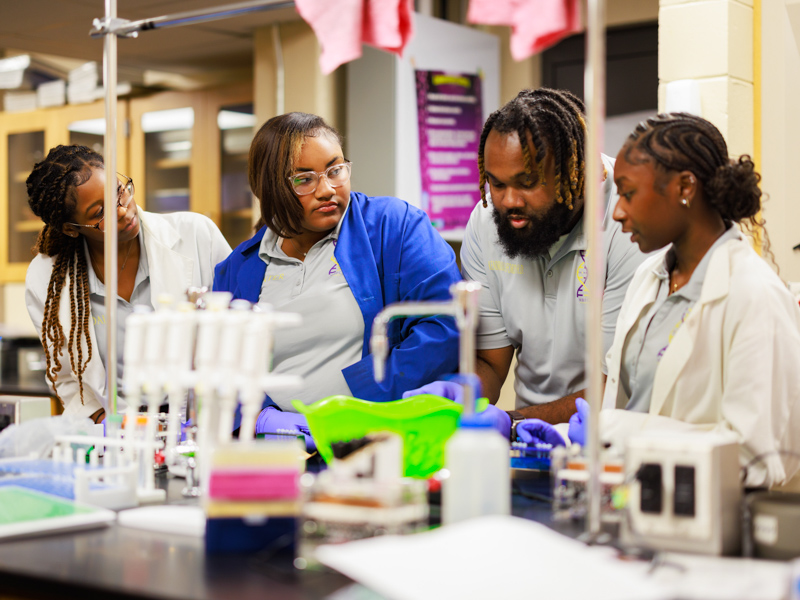
Base Pair began as a modest collaboration between UMMC and its across-the-street neighbor, the Jackson school district’s Murrah High. It pairs UMMC faculty with junior and senior students and their teachers, allowing each teen to experience the scientific field hands-on under the guidance and supervision of Medical Center researchers.
With generous funding from the Phil Hardin Foundation of Mississippi, the Mississippi Base Pair Consortium was begun in 2020. The idea was to expand Base Pair to high schools that would collaborate with local universities such as the University of Mississippi, University of Southern Mississippi, Jackson State University, Mississippi State University and Delta State University. Base Pair operated for two years at MSU, graduating several students who worked with MSU faculty mentors.
Base Pair has been welcomed by Dr. Sydney Murphy, dean of the School of Graduate Studies in the Health Sciences, as an ongoing part of the SGSHS’ educational outreach. Its expansion with the backing of the SGSHS administration is enabling hundreds more of the state’s teens, over time, to get experiences that can impact their education going forward, from college to graduate school and beyond.
Hawkins, Murphy said, “is phenomenal. She has a passion for these students and is giving them as many opportunities as she possibly can. She has a different perspective that she can offer them.”
In May 2025, the first cohort of Mississippi Base Pair Consortium-Hattiesburg students will graduate with the tools to feel at home in a college research lab and the hands-on work that allows them to explore careers as scientists.
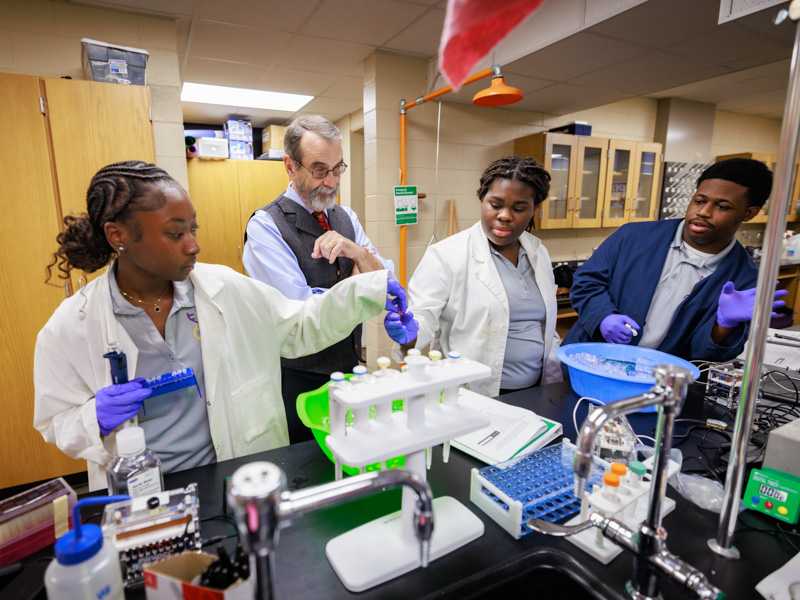
“Once they graduate, they’ll have this experience,” Rockhold said. “They won’t have so many jitters when they get their PhD.
“We’re looking to the future.”
So are the Hattiesburg High Base Pair students.
Junior Myah Eaton, 16, isn’t planning to become a scientist – for now. She’s still intrigued by biomedical research.
“I want to become a surgeon,” she said. “Base Pair gives me research experience and will help me get a foot in the door.”
Base Pair students develop a true identity as a scientist by presenting their findings through conferences, abstracts and peer-reviewed publications. Academic credit toward graduation, career orientation and advanced laboratory training in the biomedical sciences are benefits provided by the program.
Base Pair student research and publications have been cited more than 450 times. With a 100 percent high school graduation rate and 99 percent college matriculation rate, Murrah High’s Base Pair alumni have earned many millions of dollars in scholarships. Dozens have gone on to medical or dental school, graduate school or law school.
Recognition of Base Pair at Hattiesburg High came swiftly. Just two years into the program, the Mississippi Base Pair Consortium-Hattiesburg earned the 2024 Governor’s Award of Distinction, the highest recognition bestowed by the Mississippi Association of Partners in Education.
Hattiesburg High Base Pair students have two research areas: one in which students work on their own individual projects alongside research scientists and graduate students in USM labs, and one in which students work on the Wolbachia Rodeo project with Buford every Thursday at their school lab.
Buford, an assistant teaching professor with USM’s Center for STEM Education, began his involvement with Base Pair in 2019. At USM and Hattiesburg High, Buford helps bridge the gap between students’ emerging knowledge and hands-on lab experiences in partnership with other educators and researchers that include Dr. Julie May, a research scientist with the Center for STEM Education and neurophysiologist by trade; Dr. Julie Cwikla, professor of mathematics education and director of the Center for STEM Education; Hawkins, a human anatomy and physiology teacher and Hattiesburg High’s Base Pair leader; and Rockhold.
Buford is classically trained to work with high school students. “I can convince them why college is important and hopefully reverse the brain drain in Mississippi,” he said. Hattiesburg High students with stellar ACT scores can apply for Base Pair each February. After a series of interviews, those chosen are students “who are the best fit to represent the high school and who are mature enough to mentally prepare to go into the lab,” Hawkins said.
“We are starting off small because we have five labs available at USM, but we’re hoping to add five more,” Hawkins said. “Until then, we will keep a cap of 12 students.”
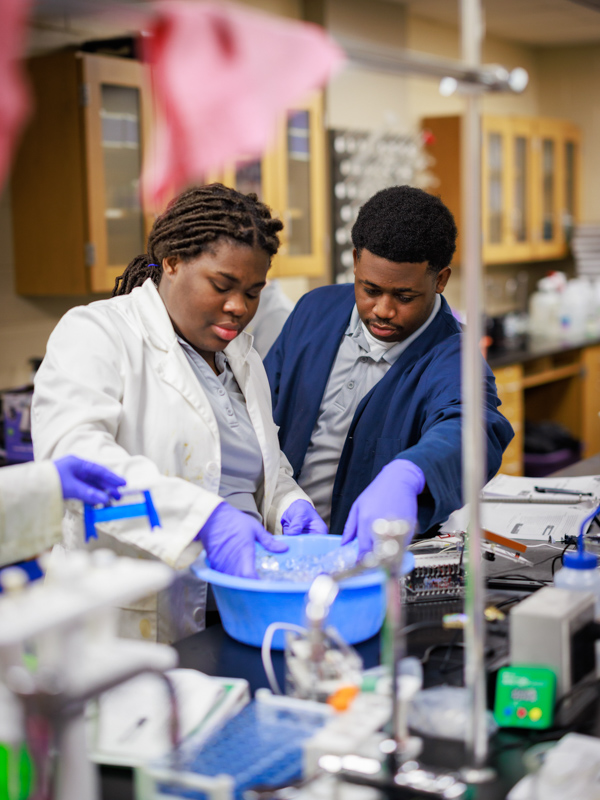
Hattiesburg High was a good candidate for Base Pair because the school district and a local public university were willing to put the resources into it, said Dr. Stephen Stray, UMMC professor of advanced biomedical education and cell and molecular biology, who mentored his first Murrah Base Pair students in the mid-2000s.
There’s not an expectation that Base Pair students go into research, “although we’re delighted when they do,” Stray said. It’s exciting to see the students go on to their future career, whatever it is.
“We have graduates who are now on faculty here at UMMC. We have people all over the state and certainly all over the Southeast who have been through Base Pair,” Stray said.
The Hattiesburg High students have skin in the game. They held fundraisers to pay for their matching blue MBPC polo shirts, wearing them with black pants, Hawkins said.
“I enjoy most when they come back from the research lab and say, ‘Mrs. Hawkins, we did this technique in the lab, and you taught us how,’” she said. “Research is like muddy water, but when you find a jewel, the students are like, ‘Hey! I found it!’”
Working with May, the students are developing their own theories of different factors that may contribute to orthopaedic deformities of the knee. A few of the factors they’re investigating are ethnicity, gender and weight.
“We are leading them through a research project of their own, and there’s more personal responsibility on them,” May said. “We want them to be independent as student researchers.”
Hattiesburg High senior NaCarma Weary, 18, is relaxed and focused during her lab time at USM. On this day, she’s working with lab assistant John Vines, a master of cell biology student, to explore how white blood cells play a key role in the body’s immune response.
“I’ve got a gel prepared for us,” Vines tells Weary. As part of the day’s work, she combines with the gel a digested plasmid, a small, circular, double-stranded DNA molecule. At the end of the process, it will take about an hour to read the results.
Weary plans to attend the University of Mississippi and major in psychology. Base Pair, she said, will figure in as she figures out what her future could entail.
“It’s showing me if I want to do clinical science and lab work,” Weary said. “It’s giving me the opportunity to explore areas that I never thought I’d explore. And, we get to mentor the juniors and help smooth their way to mentorship when they’re seniors.”
Maurice Sutton, 17, is a senior and strong safety on Hattiesburg High’s football team. He’s bound for Pearl River Community College in the fall to prepare for an electrical engineering degree he will earn at a four-year college, hopefully one where he can continue to play football.
“I’ve always been interested in the sciences,” Sutton said. “When my teacher told me about Base Pair, it sparked my interest. I jumped on it.”
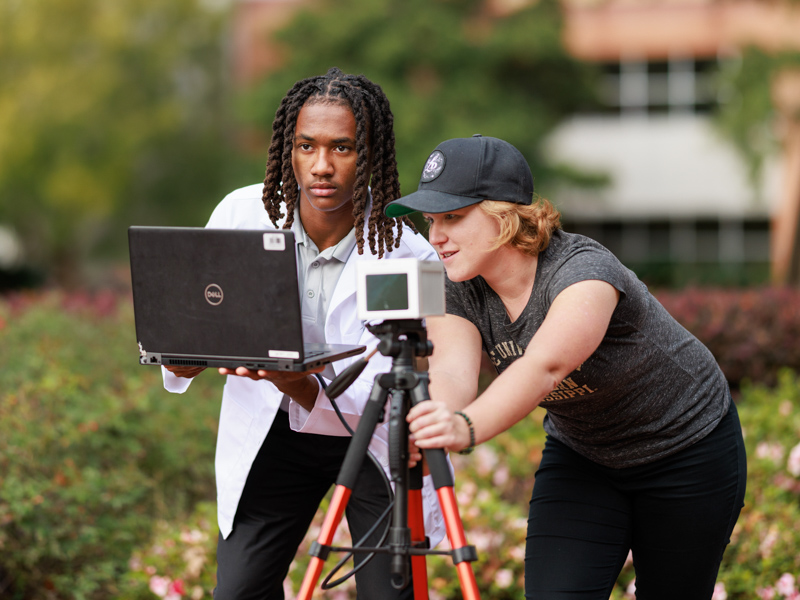
For his individual project, he’s using a 3D scanner at USM perched atop a tripod stand to scan just about anything.
“Trees, people,” he said. “It shows an outline or a landscape of what’s physically in front of you. Once you scan it, you can make the coordinates.”
His project even allows him to develop data on blues music. “I pick the artists,” he said. “I could go to a juke joint and put it in my project.
“My alpha class,” Hawkins tells the group at the conclusion of the classroom portion of their Thursday Base Pair class. “I love y’all. You are free to go.”
In the lab next door, Buford shows his sense of humor as he coaches students through the Wolbachia Rodeo. “What if I told you to program this?” he said of their data collection using “mini” PCR machines to heat and cool samples.
“Could you do it? If you trust me and you trust Mrs. Hawkins, you can push that button and something happens,” he said to students gathered around a laptop under Rockhold’s watchful eye.
Sometimes, technology cooperates. This day it didn’t, and the students’ brows furrowed as they tried to figure out why things weren’t going to plan. “No pressure!” Buford said.
“We don’t quit in Base Pair. We troubleshoot,” he told the class.
“That’s research!” Rockhold said.


